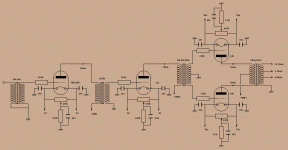A secondary loading resistor is commonly used to dampen the transformer, improving response markedly.
At RF, reactance (Miller effect, phase shifts) and losses contribute a non-infinite impedance. Given the shortcomings of transformers (and DHTs, for that matter), they're of almost no use for wideband audio applications.
Tim
At RF, reactance (Miller effect, phase shifts) and losses contribute a non-infinite impedance. Given the shortcomings of transformers (and DHTs, for that matter), they're of almost no use for wideband audio applications.
Tim
Transformer-coupled amps like that were used back in the olden days when triodes had very low mu. The voltage gain from the transformers was a significant part of the total voltage gain of the amplifier. When higher mu valves became available people switched to R and C instead for coupling, except where grid current would be an issue such as Class B PA output stages.
wideband audio
Oxymoron.
What is it you want that is beyond the capabilities of a transformer or DHT?
John
Hardly.
Given that "audio" is already quite wide (three decades), "wideband" implies an amplifier for audio purposes whose bandwidth is still wider, perhaps 4 or more decades (7-70,000Hz, say), or alternately, the same bandwidth but with much flatter gain or phase demands.
Making a transformer that goes beyond 5 decades is ridiculously difficult (it can be done, but why would you want to?), and even then, transformers that are flat enough for [regular] audio purposes are pricey to begin with.
There are much more demanding applications, mostly towards instrumentation purposes, where flatness of only, say, 1dB would be completely useless. 1dB is a very high tolerance to put on a quality audio amp.
As for DHTs, none have performance (perveance, gain, distortion, efficiency, let alone cost) near heater-cathode types. If you're already going to make a tube amp, you might as well not shoot yourself in the foot with inferior devices.
Tim
Given that "audio" is already quite wide (three decades), "wideband" implies an amplifier for audio purposes whose bandwidth is still wider, perhaps 4 or more decades (7-70,000Hz, say), or alternately, the same bandwidth but with much flatter gain or phase demands.
Making a transformer that goes beyond 5 decades is ridiculously difficult (it can be done, but why would you want to?), and even then, transformers that are flat enough for [regular] audio purposes are pricey to begin with.
There are much more demanding applications, mostly towards instrumentation purposes, where flatness of only, say, 1dB would be completely useless. 1dB is a very high tolerance to put on a quality audio amp.
As for DHTs, none have performance (perveance, gain, distortion, efficiency, let alone cost) near heater-cathode types. If you're already going to make a tube amp, you might as well not shoot yourself in the foot with inferior devices.
Tim
Last edited:
If I'm not wrong, since the secondaries of the input transformer are open, the reflected impedance to the primary is practically infinite and the source sees only the inductance of the primary which must be around 5K at 100H. Is that right?
This case, where the secondaries are effectively open, is essentially identical to inductance loading. The minimum requirement for that is that the inductive reactance be at least equal to the load impedance at the lowest frequency of interest. Four or five times would be better still, but frequently impractical at audio frequencies.
I can't figure out, why such a wide frequency spectrum for an audio amplifier is needed for. Maybe something to do with rising time.
Besides, the measurements I've got with the amplifiers are very good.
For phase margin and stability when operating with gNFB. Given that the original schemo has multiple xfmr coupled stages, no way in hell are you gonna be able to wrap a NFB loop around that thing and not make an oscillator.
- Status
- This old topic is closed. If you want to reopen this topic, contact a moderator using the "Report Post" button.
- Home
- Amplifiers
- Tubes / Valves
- Impedance matching
